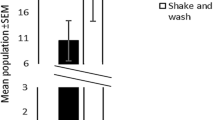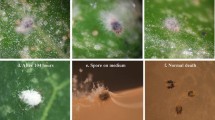Abstract
Tetranychus urticae is a widespread polyphagous mite, found on a variety of fruit crops. Tetranychus urticae feeds on the underside of the leaves perforating plant cells and sucking the cell contents. Foliar damage and excess webbing produced by T. urticae can reduce fruit yield. Assessments of T. urticae populations while small provide reliable and accurate ways of targeting control strategies and recording their efficacy against T. urticae. The aim of this study was to evaluate four methods for extracting low levels of T. urticae from leaf samples, representative of developing infestations. These methods were compared to directly counting of mites on leaves under a dissecting microscope. These methods were ethanol washing, a modified paraffin/ethanol meniscus technique, Tullgren funnel extraction and the Henderson and McBurnie mite brushing machine with consideration to: accuracy, precision and simplicity. In addition, two physically different leaf morphologies were compared; Prunus leaves which are glabrous with Malus leaves which are setaceous. Ethanol extraction consistently yielded the highest numbers of mites and was the most rapid method for recovering T. urticae from leaf samples, irrespective of leaf structure. In addition the samples could be processed and stored before final counting. The advantages and disadvantages of each method are discussed in detail.



Similar content being viewed by others
References
Alford DV (2007) Pests of fruit crops—a colour handbook. Academic Press (an imprint of Elsevier, 30 Corporate Drive, Suite 400, Burlington, MA 01803, USA, pp 425–426)
Evans GO, Sheals JG, Macfarlane D (1961) The terrestrial Acari of the British Isles. An introduction to their morphology, biology and classification. Trustees of the British museum, London, p 219
Faraji F, Bruin J, Bakker FM (2004) A new method for mite extraction from leaf samples. Exp Appl Acarol 32:31–39
Henderson CF, McBurnie HV (1943) Sampling techniques for determining populations of the citrus red mite and its predators. U.S. Department of Agriculture, Circulars no. 671. Washington, pp 1–11
Herbert HJ, Butler KP (1973) Sampling systems for European red mite, Panonychus ulmi (Acarina: Tetranychidae), eggs on Malus in Nova Scotia. Can Entomol 105:1519–1523
Hossain SKM (1992) Comparison of sampling techniques for the European red mite, Panonychus ulmi (Koch) (Acari: Tetranychidae) and the Malus rush mite, Aculus schlechtendali (Nalepa) (Acari: Eriophyidae). Acta Agric Scand Sect B Soil Plant Sci 42:128–132
Jones JL, Prendergast DT (1937) Method of obtaining an index to density of field populations of citrus red mite. J Econ Entomol 30:934–940
Krantz GW (1978) A manual of acarology, 2nd edn. Oregon S.U. Book Stores Inc., Corvallis, pp 77–80
Morgan CVG, Chant DA, Anderson NH, Ayre GL (1955) Methods for estimating orchard mite populations, especially with the mite brushing machine. Can Entomol 87(5):189–200
Nansen C, Sidumo AJ, Gharalari AH, Vaughn K (2010) A new method for sampling spider mites on field crops. Southwest Entomol 35:1–10
Nef L (1971) Influence de l’humiditẻ sur le gẻotactisme des Oribates (acarina) dans l’extractor de Berlese-Tullgren. Pedobiologia 11:433–445
Newell IM (1947) Quantative methods in biological and control studies of orchard mites. J Econ Entomol 40:683–689
Nordengen I, Klingen I (2006) Comparison of methods for estimating the prevalence of Neozygites floridana in Tetranychus urticae populations infesting strawberries. J Invertebr Pathol 92:1–6
Tullgren A (1918) Ein Sehr einfacher ausleseapparat furterricole tierfauned. Z Angew Entomol 4:149–150
Van Leeuwen T, Vontas J, Tsagkarakou A, Dermauw W, Tirry L (2010) Acaricide resistance mechanisms in the two-spotted Tetranychus urticae and other important Acari: a review. Insect Biochem Mol Biol 40:563–572
Wise JC, Gut LJ, Thornton G (1999) Cherry, control of spider mites and European red mites. In: Saxena KN (ed) Arthropod management tests, vol 24. Entomological Society of America, p 71
Acknowledgements
We would like to thank the Agriculture and Horticulture Development Board for supporting this study and the Nuffield Research Placements for their assistance.
Author information
Authors and Affiliations
Corresponding author
Rights and permissions
About this article
Cite this article
Harris, A.L., Ullah, R. & Fountain, M.T. The evaluation of extraction techniques for Tetranychus urticae (Acari: Tetranychidae) from apple (Malus domestica) and cherry (Prunus avium) leaves. Exp Appl Acarol 72, 367–377 (2017). https://doi.org/10.1007/s10493-017-0154-6
Received:
Accepted:
Published:
Issue Date:
DOI: https://doi.org/10.1007/s10493-017-0154-6




